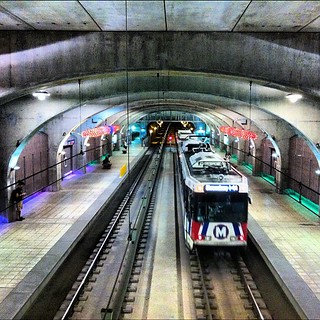 Metro plans to make a lump sum payment of $400M to pay down its outstanding debt, according to KMOX. The remaining $100M debt will be refinanced. The payment is made possible by the April 2010 passage of Prop A in St. Louis County, which levied a 0.5% sales tax to support Metro. Its passage also meant that a 0.25% sales tax approved by City voters years prior finally went into effect. Prop A passage promised to put Metro on stable financial footing in a state that provides virtually no transit funding.
Metro plans to make a lump sum payment of $400M to pay down its outstanding debt, according to KMOX. The remaining $100M debt will be refinanced. The payment is made possible by the April 2010 passage of Prop A in St. Louis County, which levied a 0.5% sales tax to support Metro. Its passage also meant that a 0.25% sales tax approved by City voters years prior finally went into effect. Prop A passage promised to put Metro on stable financial footing in a state that provides virtually no transit funding.
The agency found itself deep in debt following construction of the $676M Blue Line, which opened in 2006. Overall system service was drastically cut following the failure of St. Louis County voters to pass Prop M, a 0.5% transit sales tax. Prop A restored much of that service and Metro once again looked toward expansion. Then Metro initiated the Moving Transit Forward initiative to gather public feedback regarding future MetroLink and MetroBus service.
After all that, the politics, the proposition votes and public planning, future plans have been relatively quiet. Metro isn’t about to embark on another Blue Line, an 8-mile line completed without Federal matching funds. Considering a modern streetcar network has somehow been wholly absent from any planning or discussion. The Loop and now the Partnership for Downtown have filled that gap. Following the process, what’s coming into focus is an attempt to serve commuters with Bus Rapid Transit (BRT) on the region’s radiating Interstates.

{the Loop Trolley, the result of private planning, may start construction this year}

{a modern streetcar connecting Downtown to the Central West End is being studied by the private Partnership for Downtown St. Louis}
During a public meeting held more than a year ago, attendees were given the opportunity to plan their own transit system expansion. The rough outline was a budget of $500M over 30 years and options for light rail lines or BRT. The gist of the budgeting exercise was that St. Louis could add one ~8mi light rail line for the same cost as 100 miles or more of BRT, enough for a very robust BRT network on virtually all the region’s major thoroughfares. Given these choices, any reservations about BRT could be put aside in favor of envisioning a true transit network.
And yet, a BRT system isn’t what’s being envisioned at all. The current status of Metro expansion is focused on evaluating four Interstate commuter BRT lines (I-55, I-44, I-64 and I-70). Two of the four will be selected for further evaluation. A full BRT line isn’t planned for Grand Avenue, the system’s busiest line, but longer buses will be put into service to accommodate riders.

{BRT Metro map}
Unfortunately, it can be anticipated that St. Louis County will work hard to build more commuter rail and bus lines in lieu of a more dense, functional transit system. It’s another point at which to consider in what way a combined (in whatever sense) City and County might affect transit planning. Would the combined County officials object to a north-south light rail line east of Kingshighway? Does a transit approach reaching to the I-270 outer belt makes sense in a region of disperse residents and employment?

{access to shopping from the Brentwood MetroLink station is a planning failure}
Ultimately, does it makes sense to build transit that could help shape a more sustainable future, or build to reach commuters and suburban job centers of today? Besides simply wanting a piece of transit funding, it’s difficult to justify suburban expansion given the response to the Blue Line by county municipalities. Accessibility to shopping centers from transit stations has been ignored, or purposely made unattractive. The largest development project built in the last eight years at a Blue Line station? A Mini car dealership. The Shrewsbury station is largely a park and ride stop and as such is being used as an argument in favor of a $100M grade-separated highway project that (proponents argue) increase park and ride access.

{a car dealership represents to most significant investment adjacent to a Blue Line station other than Washington University projects}

{the Sunnen Station lost a neighborhood and gained a car dealership}
At this point, it’s unlikely Metro would like to entertain a new discussion on just what type of transit expansion is needed. And yet, a 30-year plan should be an ongoing conversation informed by our past experiences. Why not publicly consider Metro support for and operation of a streetcar network? Why not envision a BRT network and not just Interstate lines? None of this mattered before Prop A, when Metro was broke. Public planning sessions only garner so much interest until expansion seems possible. The $400M debt payment is the biggest step forward for Metro in a decade, and more importantly, enables a much bigger step to be taken next.
Saint Louis Rapid Transit Connector Study
Rapid Bus Transit as a Substitute for Light Rail Transit by nextSTL


